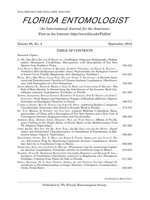Ants in the genus Dinoponera (Hymenoptera: Formicidae: Ponerinae) are among the largest sized Formicidae of the World. In Brazil Dinoponera has an allopatric distribution, and several species occur in threatened biomes. We characterized karyotypes of the following 4 species: Dinoponera australis Emery, Dinoponera gigantea Perty, Dinoponera lucida Emery, and Dinoponera quadriceps Santschi. Karyotype analysis found that all 4 species have high numbers of small-sized chromosomes (D. australis, 2n = 114; D. gigantea, 2n = 82; D. lucida, 2n = 118/120; D. quadriceps, 2n = 92). A moderate variation in chromosome number was observed among the 4 species, which suggests the occurrence of chromosome rearrangements during karyotype evolution in Dinoponera. An exclusive AMT chromosome pair was found to occur in all Dinoponera species studied thus far, which we conclude is a probable synapomorphy in Dinoponera.
How to translate text using browser tools
1 September 2012
Karyotype Differentiation among Four Dinoponera (Formicidae: Ponerinae) Species
Igor S. Santos,
Jacques H.C. Delabie,
Janisete G. Silva,
Marco A. Costa,
Luisa A. C. Barros,
Silvia G. Pompolo,
Cléa S. F. Mariano

Florida Entomologist
Vol. 95 • No. 3
September 2012
Vol. 95 • No. 3
September 2012
citogenética
cytogenetics
Formicidae
Hymenoptera
Ponerinae




